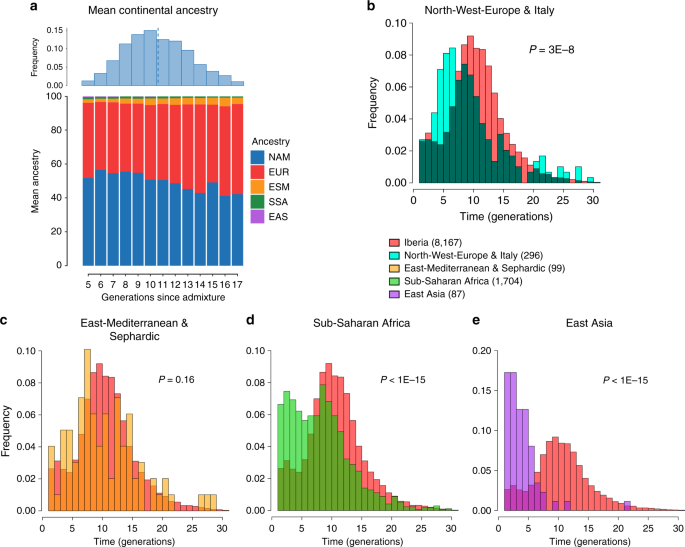Angela
Elite member
- Messages
- 21,823
- Reaction score
- 12,329
- Points
- 113
- Ethnic group
- Italian
Thanks to Lazaridis for the heads up.
However, I fail to see how they can distinguish "Converso" ancestry from any other "additional" Eastern Med ancestry, i.e. Phoenicians. Or, given so many of the migrants who went to the New World were from places like Extremadura and Andalucia, Moors/Arabians and/or more eastern Mediterranean migrants during the Bronze Age, if it shows up. The Raveana et al paper on Italy definitely finds it in what I assume is southern or south/central Spain.
It's not like Sephardim are able to be specifically distinguished, unlike Ashkenazim. They didn't go through that kind of bottleneck.
I mean, this sounds a bit like the Sikeliot school of population genetics.
I'll wait until they have ancient dna samples of the Moors, Arabs, Phoenicians, Jews, and Christians of that era in Spain for comparison before I come to those kinds of conclusions.
See:
Latin Americans show wide-spread Converso ancestry and imprint of local Native ancestry on physical appearance
https://www.biorxiv.org/content/early/2018/01/23/252155
"Abstract
"Historical records and genetic analyses indicate that Latin Americans trace their ancestry mainly to the intermixing (admixture) of Native Americans, Europeans and Sub-Saharan Africans. Using novel haplotype-based methods, here we infer sub-continental ancestry in over 6,500 Latin Americans and evaluate the impact of regional ancestry variation on physical appearance. We find that Native American ancestry components in Latin Americans correspond geographically to the present-day genetic structure of Native groups, and that sources of non-Native ancestry, and admixture timings, match documented migratory flows. We also detect South/East Mediterranean ancestry across Latin America, probably stemming mostly from the clandestine colonial migration of Christian converts of non-European origin (Conversos). Furthermore, we find that ancestry related to highland (Central Andean) versus lowland (Mapuche) Natives is associated with variation in facial features, particularly nose morphology, and detect significant differences in allele frequencies between these groups at loci previously associated with nose morphology in this sample."
Edit to correct link to paper.
However, I fail to see how they can distinguish "Converso" ancestry from any other "additional" Eastern Med ancestry, i.e. Phoenicians. Or, given so many of the migrants who went to the New World were from places like Extremadura and Andalucia, Moors/Arabians and/or more eastern Mediterranean migrants during the Bronze Age, if it shows up. The Raveana et al paper on Italy definitely finds it in what I assume is southern or south/central Spain.
It's not like Sephardim are able to be specifically distinguished, unlike Ashkenazim. They didn't go through that kind of bottleneck.
I mean, this sounds a bit like the Sikeliot school of population genetics.
I'll wait until they have ancient dna samples of the Moors, Arabs, Phoenicians, Jews, and Christians of that era in Spain for comparison before I come to those kinds of conclusions.
See:
Latin Americans show wide-spread Converso ancestry and imprint of local Native ancestry on physical appearance
https://www.biorxiv.org/content/early/2018/01/23/252155
"Abstract
"Historical records and genetic analyses indicate that Latin Americans trace their ancestry mainly to the intermixing (admixture) of Native Americans, Europeans and Sub-Saharan Africans. Using novel haplotype-based methods, here we infer sub-continental ancestry in over 6,500 Latin Americans and evaluate the impact of regional ancestry variation on physical appearance. We find that Native American ancestry components in Latin Americans correspond geographically to the present-day genetic structure of Native groups, and that sources of non-Native ancestry, and admixture timings, match documented migratory flows. We also detect South/East Mediterranean ancestry across Latin America, probably stemming mostly from the clandestine colonial migration of Christian converts of non-European origin (Conversos). Furthermore, we find that ancestry related to highland (Central Andean) versus lowland (Mapuche) Natives is associated with variation in facial features, particularly nose morphology, and detect significant differences in allele frequencies between these groups at loci previously associated with nose morphology in this sample."
Edit to correct link to paper.
Last edited:


